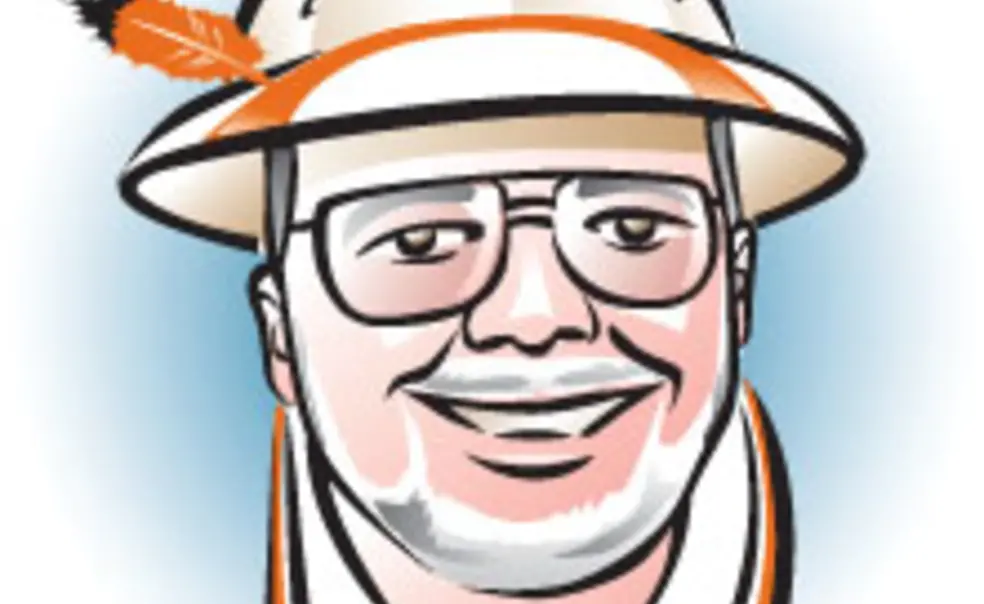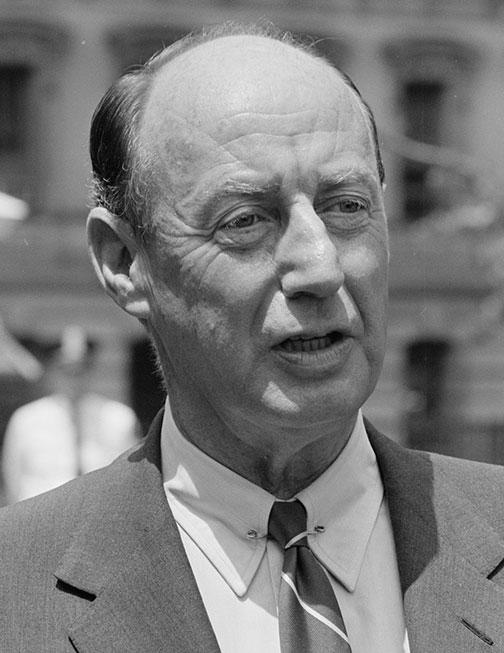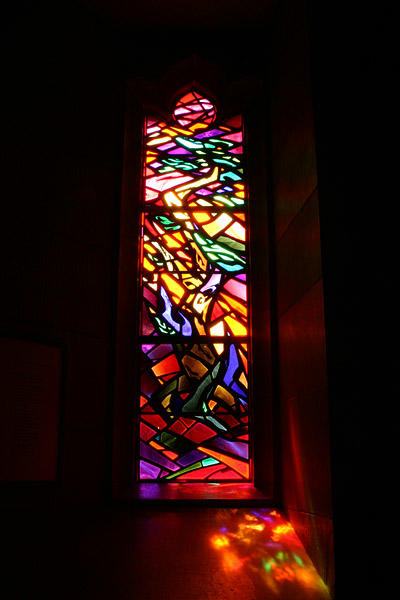It was fascinating seeing Al Gore speak to the seniors on Class Day this year; it leads to rumination on the fate of losers – if indeed winning the popular vote for president of the United States is to be considered losing – vis-à-vis winners in our tweety culture and time. Aside from his freedom to get down and joke with the undergrads rather than being forced solely to pontificate from the daises of global conferences of sovereign nations, Gore, self-identified as one of the 100 funniest people on C-SPAN, gets to tell Tommy Lee Jones stories whenever he wants, and to focus from a bully pulpit on things that are important to him, rather than his constituents.
Which leads us back 60 years to one of the three best speeches ever given on the topic of Princeton University, perhaps a bit behind Woodrow Wilson 1879’s “Princeton in the Nation’s Service,” perhaps a tiny bit ahead of Toni Morrison’s “The Place of the Idea; The Idea of the Place,” but as ringing a tribute to a liberal education as there ever has been on our campus, by a man who could write for the ages and, intriguingly, would be aghast at being compared to two winners of the Nobel Prize. It’s hardly a surprise to us, though: Wilson, famed historian, orator, governor, and president, had arisen as one of the first managing editors of the Prince, and was succeeded 43 years later in that position by Adlai Stevenson II ’22, who himself went on to be an architect of the United Nations, governor of Illinois, and candidate for president.
I was delighted to witness a moment ago your emphatic approval of my program for Princeton some 32 years ago — unlimited cuts, non-compulsory Chapel, and student firing of the Dean. I always considered that it was wise in politics to have — shall we say — a popular program. The trouble is that when I went into politics it appears that I changed my views.
Returning to Princeton for the first time following his initial presidential loss, ex-governor Stevenson came in March of 1954 to reminisce with classmates, to show his 17-year-old son around, and most notably to speak to the festive dinner of the senior Class of 1954. The Korean War had ended in a muddle nine months before, and the topic of fixation in the United States was Sen. Joe McCarthy and his battle with putative communists. The issue had risen to fever pitch: The dinner took place 13 days after Edward R. Morrow’s landmark television broadcast attacking McCarthy’s methods, and exactly one month prior to the opening of the Army-McCarthy hearings that would begin the senator’s downfall. Stevenson detested McCarthy’s closed-minded phantasmagoria, and saw it as contrary to anything this country – and Princeton – had ever stood for. He placed the blame squarely on his own generation, but pointed out that the Class of ’54 and its fellows would have to face and battle it regardless.
Things didn’t turn out as we had thought they would in 1922, and somehow the hope and easy confidence we felt dissolved as more and more the articulate and vocal among us doubted their beliefs and believed their doubts. Nor do I need to enumerate for you in sepulchral tone the problems that you face. You know them only too well. Perhaps you can solve them. I would not presume to tell you how to do it. This university has given you the tools with which to try.
And thus to the theme of the entire piece, “The Educated Citizen.” Following a litany of the foibles, weaknesses, and distractions of a democracy with 155,000 governmental units and a million elected officials, and in turn the blatant danger of any failure of this system to the fate of the world (which was a serious daily topic during the Cold War, children), Stevenson offers his solution, the very same one proffered by Wilson and Morrison.
The world’s fate now hangs upon how well or how ill we in America conduct our affairs. And if a bad man is elected trustee of a sanitary district, or if an able man in Washington is left to shift for himself in the face of unjustified attack, then our government is diminished by that much — and even more because others will lose heart from his example. So you as educated, privileged people have a broad responsibility to protect and improve what you have inherited and what you would die to preserve — the concept of government by consent of the governed as the only tolerable way of life.
There we have the Idea of the Place, Princeton in the Nation’s Service, and crucially, the concept of the privileged people who must advance them.
Now, you may not be aware, but there is currently a kerfuffle at Alma Mater regarding a truly wretched phrase: “Check your privilege.” I adore a good kerfuffle (not to mention the excuse to use the term in conversation), but this is not a good one, because both sides are loud, vacuous, and wrong. But since it’s splayed itself across media from the Tory to the Prince to Ebony to Time magazine, and since Adlai Stevenson said substantially more in this one address than the entire debate, including all its tweets and websites, has yet generated, we should listen to him. His message: We here are all privileged, and thus responsible.
Communism is a perversion of the dream of justice. And while we see its leading attribute as the perversion, the illiterate, the toiling masses still have their eyes fixed on the dream. We, too, have a powerful weapon, truth, and we gain our strength from our thoughtful citizenry, which seeks and holds the truth with both its heart and its mind. The question is, however, whether we have come to decisive responsibility too early, before we were ready, before we had matured sufficiently. No man can say with certainty. Personally I am optimistic and confident, but this question will not be answered tomorrow; it will be answered in your lifetime, and it will be answered in large part by you, the privileged American.
He was not talking about the preppies in the Class of 1954, or the Protestants, or the rich kids, or the Princeton legacies. Every single person in the room had a draft card, every single one had lived through World War II and Korea, every single one would three years later get a rude jolt from Sputnik. Now, some were great admirers of President Dwight Eisenhower, who would not vote for Stevenson in 1956, and who somehow would connect Richard Nixon to Eisenhower rather than McCarthy, and vote for him in 1960. Others would see the “egghead” Stevenson as the harbinger of a populist movement, and vote for him in 1956 and, oddly, for the magnetic and superrich Jack Kennedy in 1960. But they were all privileged; and with the privilege went the duty to serve and to battle for the betterment of everyone, as best they knew how.
Here’s the deal: Anyone who has matriculated or taught at Princeton – ever – is privileged; if there’s any matter of degree, it’s of no consequence at all. This is akin to original sin (for you theological types): Since it’s universal, it’s pretty silly to accuse another person of it, without including yourself; conversely, it’s pretty silly to argue that you’re not privileged, or complain when someone points it out. Let him without privilege cast the first tweet, if you would. We should all shelve the paranoia, polish our humility, and get to work.
And how glorious that work can be! Stevenson, after recalling the history of universities such as Princeton and their quest to shed light in the darkness, left the departing ’54 seniors (in the most frequently quoted portion of the address) with a mystical recollection of the power of such privilege, and the wonders it can inspire.
I hope you will carry away with you some of the wise serenity of the timeless courage, the unhurried objectivity which is the atmosphere of Princeton and which represents the collective imprint of its founders, students, and teachers who have gone before you.
I came here last night in darkness, after an absence of four or five years. I came with an old friend, an old classmate. We drove a little through the campus, after dusk. It was soft, the air fresh with the beginning of spring. I thought of some words that I read here long ago, written by the English poet, Alfred Noyes, who stayed for a time on the Princeton campus. They went something like this if I am not mistaken:
Now lamp-lit gardens in the blue dusk shine
Through dogwood red and white,
And round the gray quadrangles, line by line,
The windows fill with light,
Where Princeton calls to Magdalen, tower to tower,
Twin lanthorns of the law,
And those cream-white magnolia boughs embower
The halls of “Old Nassau.”
Sentimental? Yes. Nostalgic? Perhaps. Yet beautiful, true. Your days are short here; this is the last of your springs. And now in the serenity and quiet of this lovely place, touch the depths of truth, feel the hem of Heaven. You will go away with old, good friends. And don’t forget when you leave why you came.
We’ll be back in the fall; because you’ve been good, you get a choice for your required summer reading this year. You can (my favorite option) go read and savor every word of Adlai Stevenson’s address to the Class of ’54 – I wept over virtually every word I omitted here – or you can have fun with this year’s Pre-read for the Class of 2018, Meaning in Life and Why It Matters by Susan Wolf ; or you can browse the convenient index of this year’s Rally columns that our esteemed editors have included just to your right , then write a 2,000-word essay on why your chosen column is a piece of either claptrap or singular erudition. Or both. Viva la Siesta!















No responses yet